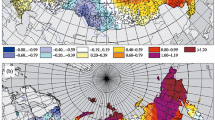Abstract
Changes in climatic parameters and in temperature and precipitation extremes in northern Eurasia in the late 20th century are analyzed. A spatial distribution of temperature and precipitation anomalies and of a set of indices of climate extremes is presented. Changes in climate extremes show a tendency toward a milder climate, mainly in winter. At the same time, the frost-free period has substantially decreased in the eastern, northern, and central parts of European Russia. In some regions during summer, there is an increase in the frequency of extreme events such as heavy rains, droughts, and sharp cooling. It is shown that the geographic pattern of present-day climate anomalies is linked to variations in the large-scale atmospheric circulation. The main mechanism of the current warming in northern Eurasia is a winter intensification of zonal flow linked to the increased frequency of positive anomalies of the North Atlantic Oscillation index.
Similar content being viewed by others
References
IPCC 2001. Climate Change 2001: The Scientific Bases. Contribution of Working Group, Ed. by J. T. Houghton, Y. Ding, D. J. Griggs, et al. (Cambridge Univ. Press, Cambridge, 2001).
R. W. Katz and B. G. Brown, “Extreme Events in a Changing Climate: Variability Is More Important Than Averages,” Clim. Change 21, 289–302 (1992).
D. B. Kiktev, D. M. Sexton, L. V. Alexander, and K. K. Folland, “Trends in the Fields of Annual Extrema of Precipitation and Surface Temperature in the Second Half of the 20th Century,” Meteorol. Gidrol., No. 11, 13–24 (2002).
P. Frich, L. V. Alexander, P. Della-Marta, et al., “Observed Coherent Changes in Climatic Extremes during the Second Half of the Twentieth Century,” Clim. Res. 19, 193–212 (2002).
K. Hage, “On Destructive Canadian Prairie Windstorms and Severe Winters,” Natural Hazards 29, 207–228 (2003)
K. E. Kunkel, “North American Trends in Extreme Precipitation,” Natural Hazards 29, 291–305 (2003).
G. V. Gruza and E. Ya. Ran’kova, Detection of Climate Changes, Climatic Variability, and Climatic Extremes,” in Abstracts of Papers of World Conference on Climate Change (IGKE, Moscow, 2003) [in Russian].
A. A. Vasil’ev and O. N. Belinskii, “Major Forms of Hydrometeorological Hazards and Their Distribution over Russia,” in Natural Hazards of Russia, Vol. 5, Hydrometeorological Hazards, Ed. by G. S. Golitsyn and A. A. Vasil’ev (Kruk, Moscow, 2001), pp. 14–24 [in Russian].
B. E. Gleason, “Data Documentation for Data Set 9101,” Global Daily Climatology Network, V 1.0, NCDC, http://www.ncdc.noaa.gov/gdcn.html
G. V. Gruza, E. Ya. Ran’kova, M. Yu. Bardin, et al., 2003 Climate Changes: Review of the Climate of Russia and Tendencies of Its Change (IGKE, Moscow, 2004) [in Russian].
S. M. Varlamov, E. S. Kim, and E. Kh. Khan, “Present-Day Temperature Variations in Eastern Siberia and the Russian Far East,” Meteorol. Gidrol., No. 1, 19–28 (1998).
N. V. Zukert and D. G. Zamolodchikov, “Variations in Air Temperature and Precipitation in the Russian Tundra Region,” Meteorol. Gidrol., No. 8, 45–52 (1997).
E. Ya. Ran’kova and G. V. Gruza, “Indicators of Climate Changes in Russia,” Meteorol. Gidrol., No. 1, 5–18 (1998).
V. M. Mirvis, I. P. Guseva, and A. V. Meshcherskaya, “Assessment of Change in the Continentality of Russian Climate from Amplitude-Phase Characteristics of the Annual Cycle of Daily Mean Air Temperature in the Past Century,” Meteorol. Gidrol., No. 7, 5–18 (1998).
J. Marshall, Y. Kushnir, D. Battisti, et al., “North Atlantic Climate Variability: Phenomena, Impacts and Mechanisms,” Int. J. Climatol. 21, 1863–1898 (2001).
J. M. Wallace, “Observed Climatic Variability: Spatial Structure,” in Decadal Climatic Variability, Ed. by D. T. Anderson and J. Willebrand (Springer, Berlin, 1996), pp. 31–81.
M. Watanabe and T. S. Nitta, “Decadal Changes in the Atmospheric Circulation and Associated Surface Climate Variations in the North Hemisphere Winter”, J. Clim. 12, 494–510 (1999).
V. V. Popova and A. B. Shmakin, “Effect of the North Atlantic Oscillation on the Long-Term Hydrothermal Regime of Northern Eurasia: I. Statistical Analysis of Observational Data,” Meteorol. Gidrol., No. 5, 62–74 (2003).
A. B. Shmakin and V. V. Popova, “Effect of the North Atlantic Oscillation on the Long-Term Hydrothermal Regime of Northern Eurasia: II. Modeling Intra-century Oscillations of the Heat and Water Balance,” Meteorol. Gidrol., No. 6, 59–68 (2003).
G. V. Gruza, E. Ya. Ran’kova, L. K. Kleshchenko, and L. N. Aristova, “On the Relationship between Climate Anomalies in Russia and the El Niño-Southern Oscillation Phenomenon,” Meteorol. Gidrol., No. 5, 32–51 (1999).
A. B. Polonsky and D. V. Basharin, “On the Influence of the North Atlantic and Southern Oscillations on the Variability of Air Temperature in the Mediterranian-European Region,” Izv. Akad. Nauk, Fiz. Atmos. Okeana 38(1), 135–145 (2002) [Izv., Atmos. Ocean. Phys. 38, 119–128 (2002)].
L. V. Nechvolodov, A. L. Lobov, N. V. Ovinova, et al., “On the Relationship between Longitudinal Heat Transfer in the North Atlantic and the El Niño-Southern Oscillation Phenomenon,” Meteorol. Gidrol., No. 6, 53–65 (1999).
V. P. Dymnikov, E. M. Volodin, V. Ya. Galin, et al., “Sensitivity of a Climatic System to Small External Forcings,” Meteorol. Gidrol., No. 4, 77–92 (2004).
T. J. Osborn, K. R. Briffa, S. F. B. Tett, et al., “Evaluation of the North Atlantic Oscillation As Simulated by a Coupled Climate Model,” Clim. Dyn. 15, 685–702 (1999).
Author information
Authors and Affiliations
Additional information
Original Russian Text © A.B. Shmakin, V.V. Popova, 2006, published in Izvestiya AN. Fizika Atmosfery i Okeana, 2006, Vol. 42, No. 2, pp. 157–166.
Rights and permissions
About this article
Cite this article
Shmakin, A.B., Popova, V.V. Dynamics of climate extremes in northern Eurasia in the late 20th century. Izv. Atmos. Ocean. Phys. 42, 138–147 (2006). https://doi.org/10.1134/S0001433806020022
Received:
Accepted:
Issue Date:
DOI: https://doi.org/10.1134/S0001433806020022




